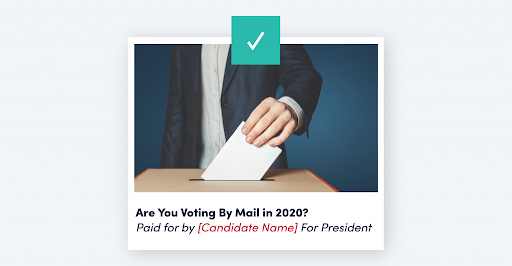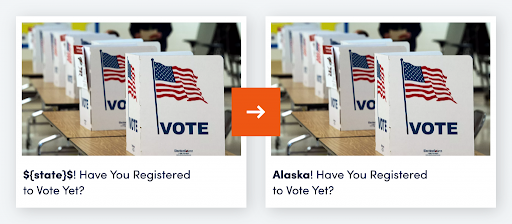The [Content] Dos and Don’ts of Political Ads

Politics is a topic you try to avoid at the family dinner table. But it’s 2024, and the way things have played out so far, there’s no chance.
Add the projected political ad spend for 2024 together with the news headlines, and the candidates and political parties will absolutely be front and center over the next few months.
Experts forecast the political ad market for US elections and advocacy issues will reach as much as $16 billion in the 2024 cycle. This marks a roughly 30% increase over the record-breaking ad spend for the 2020 presidential election.
Political ads aren’t ‘bad’ by nature – what’s problematic are some of the poor policies surrounding them.
At Outbrain, we’re proud to have some of the strictest Advertising Guidelines in the business. And given the topic’s sensitivities, they only get stricter when it comes to political ads.
We also have one of the largest ad networks in the US, so reach and exposure are yours.
If you have a narrative to tell this electoral season, benefit from a sense of confidence in the safety and adjacency of your campaign.
Read on to discover the do’s and don’ts of political ads on the non-biased Outbrain network. Included in this list of best practices, you’ll also find several political ads examples to inspire your own.
Political Ads: Dos and Don’ts
DO: Provide the clearest disclosure
Let’s start with an easy, industry-standard win.
All political ads must contain clear disclosure of who has paid for the ad no ifs, ands, or buts. This means on both the landing page and within the ad’s site name.
While this had long been the case for traditional ads on radio and television, the digital universe was exempt. Then, in 2022, the Federal Election Commission passed a new digital ad transparency rule. It requires those who place political advertising on the internet to disclose within the ad who paid for it.

DON’T: Be irrelevant or indirect (that goes for location too!)
From audience targeting to the images in your ad campaigns, nothing will hurt your performance more than a lack of relevance.
In a 2019 study, 90% of consumers deemed ads not personalized to them “annoying.” Don’t be annoying!
This is where message matching and direct urgency can be your best friends. They keep your creatives consistent and enticing from pre-click to post-click.
Here are a few examples of how to do it:
- Use similar headlines in your ads and landing pages.
- Align your design aesthetics throughout.
- Tell consumers exactly what you’d like them to do (eg. register).
- Utilize action words to drive urgency (eg. “Quick!”).
On the subject of locational relevancy, marketers must be based in the United States – that goes for your billing location as well!
DO: Take the high (and positive!) road
If you’ve seen our standard campaign best practices in the past, you may recall that negative headlines perform better than positive ones. But that switch flips when it comes to political advertising.
In fact, 52% of people surveyed during the last presidential election year (2020) said attack-based ads make them dislike the candidate and party less. They also agreed that removing political ads with a negative tone is the number one way to improve the consumer ad experience.
We did just that, disallowing ads that attempt to humiliate or disparage a candidate, party, or group.
As the old saying goes, “If you have nothing nice to say, don’t say anything at all.” So, keep your content positive – or neutral. That works too!
DON’T: Focus too much on your competitor
Speaking of taking the high road, you also want to speak for yourself.
Even if the ad experience is positive in nature, ads about your competitors tend to be deemed misleading to consumers.
Remember, when you’re promoting ads about any political candidate, you’re implying that you’re endorsing the message. And since 3 in 4 consumers already find political ads to include fraudulent or fake information, it really is best to stay in your lane.
A 2024 data analysis from The IAS Election Lab found that ads avoiding misinformation have a 29% lower cost per conversion than ads adjacent to misinformation. This equals $1.21 less per conversion (CPCV). This lower CPCV is partly thanks to ads adjacent to misinformation having a 46% lower success rate.
Try to focus on the voice of your candidate, party, or organization – you’ll gain greater trust from your future voters.
DO: Focus on the facts
This one’s pretty self-explanatory – ensure your content contains only neutral or positive stories or positions based on facts. No fake or misleading news!
And it’s important to note (again!) that Outbrain is a neutral platform. This means no ad can appear to show Outbrain as promoting any specific candidate, party, or political agenda.

DON’T: Discount the need for trust
Did you know that during the 2020 election cycle, 83% of people surveyed found it difficult to trust what they see in political ads?
Luckily, there are ways (and platforms!) to gain higher ad-trust:
- Keep things unbiased.
- Include data or statistics.
- Reinforce beliefs.
- Address important topics.
On the topic of good statistics, native ad experiences are trusted by consumers 44% more than social ads. Something to keep in mind as we’re getting closer to the 2024 presidential election.
DO: Be dynamic, B-e dynamic
Dynamic Headlines, that is.
Through Outbrain, you can dynamically add the consumers’ state or city in your headlines using a handful of fun punctuation points on the backend. This is a great way to both personalize your ads and pre-qualify your audiences (eg. “New York Democrats!”).
You’ll find even more location-based advertising tips here: 5 Easy Ways to Boost Your Local Advertising Strategy.
Bonus tips:
- Performance-wise, state callouts gain higher CTRs than city.
- Include some form of location selection in your subsiding landing page.

DON’T: Miss a reason to celebrate
You’re likely thinking, “This is similar to when a job candidate says their worst trait is being too organized,” right? You’re not wrong!
Seeing the glass half full, big events such as birthdays or holidays perform really well for candidates and political parties. It’s something to keep in mind when you’re looking for new creative inspiration.
We’re counting down the days before the presidential election on November 5th, 2024. So here’s a helpful list of US holidays and events and tips to take advantage of them, advertising-wise.

DO: Use a close-up of your candidate
The ad image sweet spot = a headshot or close-up image of your candidate.
Have one with an American flag behind them? Icing on the sweet spot cake.
And guess what? You can use images of same-party candidates, which tends to widen your political parties’ audience net across election types.
DON’T: Be negative
Seriously, just don’t.
Let’s Make It Skimmable
Remember, political ads often lead down a road of discovery or research to acquire more knowledge about candidates and political parties. And education is everything in politics.
What people don’t want is misleading, irrelevant ad experiences. It’s up to the ad platform to set strict, responsible guidelines for their advertising partners, and for all parties to stick to them.
So, be sure to use the Dos and Don’ts above as political ad guardrails and best practices before embarking on your next political ad campaign.
Dos
- Provide the clearest disclosure
- Take the high (and positive!) road
- Focus on the facts
- Be dynamic with ad titles and more
- Use a close-up ad image of your candidate
Don’ts
- Be irrelevant or indirect (that goes for location too!)
- Focus too much on the competitor
- Discount the need for trust
- Miss a reason to celebrate
- Be negative
Looking for more strategic insights for your political ad campaigns? Check out these top advertising trends and strategies in 2024.
Let Outbrain be your next digital running mate for your advertising strategy.
Discover how we support advertisers with their political strategy – from persuasion to voter registration – with prediction engagement here.


